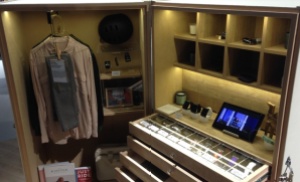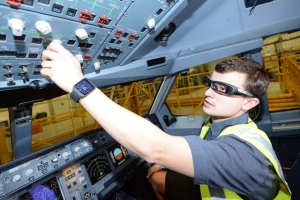by Nitin Dahad
Smart wearable technology was in fashion at the mobile industry’s big event this year, Mobile World Congress. One particular graphic I saw illustrated an image of an ecosystem connecting ‘Human to Cloud’. This partly sums up what task wearable technology performs – collecting data from being worn by a person, and delivering that to the cloud for some kind of action or feedback.
In particular, it can involve many technologies – including sensor networks, machine-to-machine communications, and augmented reality, as well as dedicated image and data processing. It has applications in textiles and fashion, medical, performance sports and retail. According to the organizers of the Wearable Technology Show in London next week, the market is young but it’s already estimated to be worth $14bn and analysts believe this will rise to over $70bn by 2024.
Its COO, John Weir, adds, “This is no flash in the pan fad. Wearables are here to stay and we are about to see them become more intrinsic to our lives – our health, wellbeing and entertainment. We are also about to see them move from mainly consumer applications to having a much bigger impact on industry.” He also says, “The Wearable Technology Show opens the morning after the Apple Watch press conference when curiosity and desire for wearables will be at an all-time high and all eyes will be on this industry.”

In fact, Sara Kami Shirazi, product marketing manager for companion products at Sony Mobile Communications, said to The Next Silicon Valley this week in Barcelona, “This is just the beginning of the wearable industry. Today’s wearable is just the embryo of what’s to come.”
She spoke about Sony’s philosophy to wearables which is about ‘modularized thinking’ – providing core products which can be customized by the customer to their own taste or preference. That is why Sony, she says, has developed a product portfolio in which each product is customizable. “The market is moving towards customized wearables,” she added. She also said that no matter how good the product is technologically, the key to a successful product is finding the right balance between technology and design. She added that wearables are just a small part of the ecosystem – that the products are also an entry point into the connected home, and its future would involve use with smart eyeglasses.
The company’s president, Hiroki Totoki, also talked about the value of wearables in industry this week in an interview with The Wall Street Journal. He commented, “The biggest benefit of wearable technologies is that they free up both hands. So we will be looking at what kind of workers want information on a real-time basis, in what kind of circumstances and what information they need.”

Testament to this, Virgin Atlantic is launching an innovative trial with Sony Mobile Communications to test how new wearable technology can help improve the airline’s maintenance and engineering processes. Engineers working on Virgin Atlantic aircraft at the airport and in the hangar will test Sony’s SmartEyeglass Developer Edition SED-E1, tablet, mobile phone and SmartWatch 3 in an eight-week trial at London Heathrow, to test how the technology can be used for real time communication between the engineering team on the aircraft and in the engineering support areas.
Using Sony’s SmartWear alongside a smart phone or tablet will remove paper from some engineering processes and reduce the journey times between an aircraft and technical control. This will enable the engineers and technicians to remain on the aircraft during turnarounds – helping to save valuable time, as well as make a significant contribution to Virgin Atlantic’s targets to reduce paper waste.
Engineers will be able to take pictures or video of the tasks they are working on. This will be linked to an app running on a smartphone which will allow the engineers to efficiently complete and submit a form requesting further technical assistance. Real-time video streaming will also allow office-based engineering staff to see a problem from the engineers’ point of view in order to provide more rapid technical assistance.
Dennis van Schie, senior vice-president, sales & marketing, Sony Mobile Communications said: “We’re excited about this partnership with Virgin Atlantic, and exploring how Sony’s SmartWear can enhance daily tasks and operations. This innovative thinking in pushing the boundaries of how these products are used is a great example of what can be done with our SmartWear and we look forward to continuing to work with Virgin Atlantic on this trial and future initiatives.”
Wearable technology obviously has many different guises and applications, which is why it is currently considered a huge market. But once we start focusing on some of the key segments and applications – such as industrial or consumer, and possibly even different verticals under each, it will be possible to understand which sectors and applications will really see the full impact of the connected devices and technology, and which will just be a passing fashion.